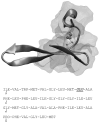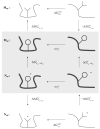Multiscale simulations of protein landscapes: using coarse-grained models as reference potentials to full explicit models
- PMID: 20052756
- PMCID: PMC2822134
- DOI: 10.1002/prot.22640
Multiscale simulations of protein landscapes: using coarse-grained models as reference potentials to full explicit models
Abstract
Evaluating the free-energy landscape of proteins and the corresponding functional aspects presents a major challenge for computer simulation approaches. This challenge is due to the complexity of the landscape and the enormous computer time needed for converging simulations. The use of simplified coarse-grained (CG) folding models offers an effective way of sampling the landscape but such a treatment, however, may not give the correct description of the effect of the actual protein residues. A general way around this problem that has been put forward in our early work (Fan et al., Theor Chem Acc 1999;103:77-80) uses the CG model as a reference potential for free-energy calculations of different properties of the explicit model. This method is refined and extended here, focusing on improving the electrostatic treatment and on demonstrating key applications. These applications include: evaluation of changes of folding energy upon mutations, calculations of transition-states binding free energies (which are crucial for rational enzyme design), evaluations of catalytic landscape, and evaluations of the time-dependent responses to pH changes. Furthermore, the general potential of our approach in overcoming major challenges in studies of structure function correlation in proteins is discussed.
Keywords: Coarse Grained model; dielectric constants; free energy calculations; proton transfer.
Figures










Similar articles
-
An effective coarse-grained model for biological simulations: recent refinements and validations.Proteins. 2014 Jul;82(7):1168-85. doi: 10.1002/prot.24482. Proteins. 2014. PMID: 25050439 Free PMC article.
-
Characterizing protein energy landscape by self-learning multiscale simulations: application to a designed β-hairpin.Biophys J. 2010 Nov 3;99(9):3029-37. doi: 10.1016/j.bpj.2010.08.041. Biophys J. 2010. PMID: 21044601 Free PMC article.
-
Transferable coarse-grained potential for de novo protein folding and design.PLoS One. 2014 Dec 1;9(12):e112852. doi: 10.1371/journal.pone.0112852. eCollection 2014. PLoS One. 2014. PMID: 25436908 Free PMC article.
-
Coarse-grained models of protein folding: toy models or predictive tools?Curr Opin Struct Biol. 2008 Feb;18(1):10-5. doi: 10.1016/j.sbi.2007.10.005. Epub 2007 Dec 21. Curr Opin Struct Biol. 2008. PMID: 18160277 Review.
-
Coarse-grained (multiscale) simulations in studies of biophysical and chemical systems.Annu Rev Phys Chem. 2011;62:41-64. doi: 10.1146/annurev-physchem-032210-103335. Annu Rev Phys Chem. 2011. PMID: 21034218 Review.
Cited by
-
pH-dependent dynamics of complex RNA macromolecules.J Chem Theory Comput. 2013 Feb 12;9(2):935-943. doi: 10.1021/ct300942z. Epub 2013 Jan 3. J Chem Theory Comput. 2013. PMID: 23525495 Free PMC article.
-
Why nature really chose phosphate.Q Rev Biophys. 2013 Feb;46(1):1-132. doi: 10.1017/S0033583512000157. Epub 2013 Jan 15. Q Rev Biophys. 2013. PMID: 23318152 Free PMC article. Review.
-
Exploring the Phospholipid Transport Mechanism of ATP8A1-CDC50.Biomedicines. 2023 Feb 13;11(2):546. doi: 10.3390/biomedicines11020546. Biomedicines. 2023. PMID: 36831082 Free PMC article.
-
Electrostatic origin of the unidirectionality of walking myosin V motors.Proc Natl Acad Sci U S A. 2013 Oct 22;110(43):17326-31. doi: 10.1073/pnas.1317641110. Epub 2013 Oct 8. Proc Natl Acad Sci U S A. 2013. PMID: 24106304 Free PMC article.
-
An effective coarse-grained model for biological simulations: recent refinements and validations.Proteins. 2014 Jul;82(7):1168-85. doi: 10.1002/prot.24482. Proteins. 2014. PMID: 25050439 Free PMC article.
References
-
- Levitt M, Warshel A. Computer-Simulation of Protein Folding. Nature. 1975;253(5494):694–698. - PubMed
-
- Dill KA. Dominant Forces in Protein Folding. Biochemistry. 1990;29(31):7133–7155. - PubMed
-
- Olszewski KA, Kolinski A, Skolnick J. Folding simulations and computer redesign of protein A three-helix bundle motifs. Proteins. 1996;25(3):286–299. - PubMed
Publication types
MeSH terms
Substances
Grants and funding
LinkOut - more resources
Full Text Sources
Other Literature Sources

